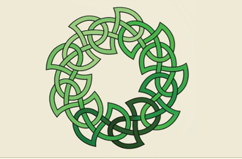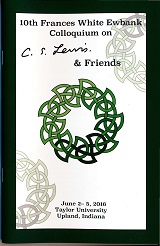Event Title
Paper Session 2-C: The Ransom Trilogy
Location
Euler 118
Start Date
3-6-2016 9:15 AM
Description
"Being "Hnau"; The Imago Dei as Explored in Gulliver's Travels and the Space Trilogy" - Abby Palmisano
"Through the Lens of The Four Loves: The Concept of Love in Perelandra" - Paulette Sauders
It is my contention that when C.S. Lewis wrote his non-fiction book The Four Loves and published it in 1960, he had not been thinking about love in all of its manifestations except for just a short time before it was written. All of the fictional works he wrote over the years, beginning in at least 1938, reflect his definitions and descriptions of the various kinds of love and their perversions that he systematically describes so well in The Four Loves. He does this in his fiction through his various characters and their actions. I will focus on Perelandra in order to reveal the ways Lewis shows the reader the four kinds of love and their perversions instead of just defining and discussing love as he does in The Four Loves.
"Separation from the King: Tinidril and Susan's Temptation in the Desert" - Kat D. Coffin
Temptation is a recurring theme in Lewis's works--particularly in the second book of the Cosmic Trilogy, Perelandra. Temptation frames the novel, the choices Ransom makes, and danger Tinidril faces. In Perelandra, Maleldil sends Ransom as an envoy to Venus, to help protect Tinidril from disobeying God. But there was no such savior for Susan Pevensie, in the Chronicles of Narnia, when she succumbed to earthly temptations instead of her Narnian destiny. She is given a few brief lines that explain her absence from the final battle. Her interest is now for "lipsticks and nylons and party invitations". This paper will be a continuation of work shared at the last Colloquium, where I considered the redemptive themes between Susan and Orual (Till We Have Faces). In continuing my study of Susan Pevensie, a much maligned and underrated character, I intend to shift to the theme of Christian temptation. This paper will seek to examine parallels between two female leaders of fantastic worlds, their varying temptations, and what Lewis might be attempting to convey about Christian temptation. Perhaps the idea of Christian temptation is not a gendered fate towards women in particular, but something all Christians must overcome.
Event Type
Paper
Paper Session 2-C: The Ransom Trilogy
Euler 118
"Being "Hnau"; The Imago Dei as Explored in Gulliver's Travels and the Space Trilogy" - Abby Palmisano
"Through the Lens of The Four Loves: The Concept of Love in Perelandra" - Paulette Sauders
It is my contention that when C.S. Lewis wrote his non-fiction book The Four Loves and published it in 1960, he had not been thinking about love in all of its manifestations except for just a short time before it was written. All of the fictional works he wrote over the years, beginning in at least 1938, reflect his definitions and descriptions of the various kinds of love and their perversions that he systematically describes so well in The Four Loves. He does this in his fiction through his various characters and their actions. I will focus on Perelandra in order to reveal the ways Lewis shows the reader the four kinds of love and their perversions instead of just defining and discussing love as he does in The Four Loves.
"Separation from the King: Tinidril and Susan's Temptation in the Desert" - Kat D. Coffin
Temptation is a recurring theme in Lewis's works--particularly in the second book of the Cosmic Trilogy, Perelandra. Temptation frames the novel, the choices Ransom makes, and danger Tinidril faces. In Perelandra, Maleldil sends Ransom as an envoy to Venus, to help protect Tinidril from disobeying God. But there was no such savior for Susan Pevensie, in the Chronicles of Narnia, when she succumbed to earthly temptations instead of her Narnian destiny. She is given a few brief lines that explain her absence from the final battle. Her interest is now for "lipsticks and nylons and party invitations". This paper will be a continuation of work shared at the last Colloquium, where I considered the redemptive themes between Susan and Orual (Till We Have Faces). In continuing my study of Susan Pevensie, a much maligned and underrated character, I intend to shift to the theme of Christian temptation. This paper will seek to examine parallels between two female leaders of fantastic worlds, their varying temptations, and what Lewis might be attempting to convey about Christian temptation. Perhaps the idea of Christian temptation is not a gendered fate towards women in particular, but something all Christians must overcome.


